CTP Episode of the Day - 09.21.06 - More Fight the Future
Today's Cherished Movie: Fight the Future
Original Release Date: June 19, 1998
Story By: Chris Carter & Frank Spotnitz
Screenplay By: Chris Carter
Directed By: Rob Bowman
M: I need you on this, Scully.
S: You don't need me, Mulder. You never have. I've just held you back. I gotta go.
M: You wanna tell yourself that so you can quit with a clear conscience, you can, but you're wrong.
S: Why did they assign me to you in the first place, Mulder? To debunk your work, to rein you in, to shut you down ...
M: But you saved me! As difficult and as frustrating as it's been sometimes, your goddamned strict rationalism and science have saved me a thousand times over. You've kept me honest ... you've made me a whole person. I owe you everything, Scully ... and you owe me nothing. I don't know if I wanna do this alone. I don't even know if I can. And if I quit now, they win.

More "Fight the Future" Tidbits & Musings:
-- One thing that the uninitiated may have had trouble figuring out was who those three guys in Mulder's hospital room were, a fact that didn't escape Chris Carter. "There were certain characters we needed to put in the movie who the fans had become very fond of and the Lone Gunmen were three of those characters," Carter said. "So it was difficult to find a way to put them in the movie and not have to explain too much who they were. Because the audience that’s been watching the television series for five years running knows who these guys are, but the non-fan would have no idea so there’s a very quick introduction to the Lone Gunman. They are explainers, they are nerd scientists, guys that are sort of 'fringe dwellers.' To put them in a scene with Agent Mulder and ultimately with Assistant Director Skinner you run the risk of bringing the movie to a dead halt. The audience not understanding who they are, what’s going on and creating or ruining the suspension of disbelief because these characters are kind of cartoon-ish. But I think we found a way to do it and to use it as a transitional piece in the story."
-- It was pretty convenient that the LGM were "explainers." While Mulder was unconscious, they apparently deduced exactly what happened to him and to Scully so they could fill Mulder in and he wouldn't have to waste time figuring things out.
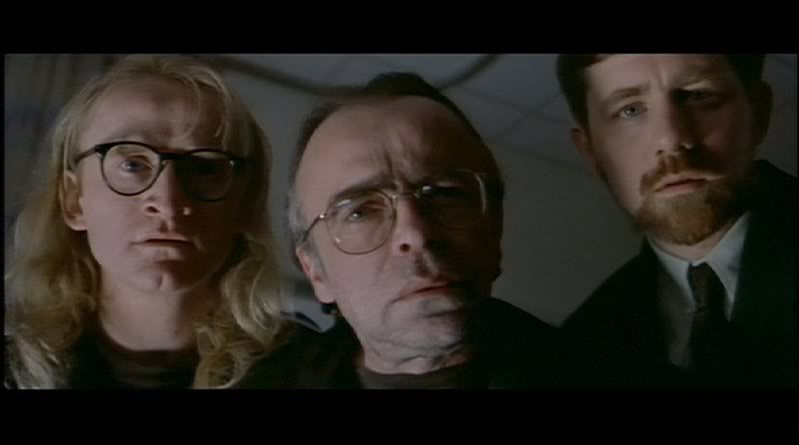
-- The man who plays the government 'overlooker' in the hallway outside Mulder's hospital room is actually the assistant director on the picture.
-- The movie blooper reel also contains a hilarious running gag featuring Mitch Pileggi as he's shooting the background scene where he's talking to someone on the telephone while Byers lays in the hospital bed so Mulder can escape. To "pretend" that he's talking on the phone, Pileggi speaks the lyrics to the entire song "Greased Lightning" from the musical Grease.
-- The gag reel also contains the famous footage of the bare bottom of Fox Mulder/David Duchovny that fans were told would make an appearance in the movie. "I can't believe that so many people would be interested in David Duchovny's butt," joked Chris Carter. "You would think that a man's butt is not all that. But we blew up the shot and framed it for posterity. In fact, we're thinking of making the next movie all about David Duchovny's butt." [Bring it on, says I.] Carter explained that David's butt actually made film in a hospital gown (the footage included in the gag reel), but "the camera position was such that the shot was unusable." [Too bad he didn't take a vote on that. < g >]
-- "It was a scene at the hospital and I get up out of the bed," said David Duchovny. "And I've got one of those hospital gowns on, and my ass was just hanging out. It was written in the script as the first time you get to see Mulder's moon, or whatever. And I thought that was funny. Again I thought it was a clever way to get really gratuitous nudity. Which I love -- gratuitous nudity. I think it's the only kind of nudity to be allowed. It's all-gratuitous. I mean, when does anybody *have* to be naked in a film? Unless you were in the movie 'Before There Were Clothes.' But I thought, okay, a really gratuitous ass shot is just wonderful. Especially cause I've been laying on it for two days in a coma, basically. I mean it was just a nasty ass shot."
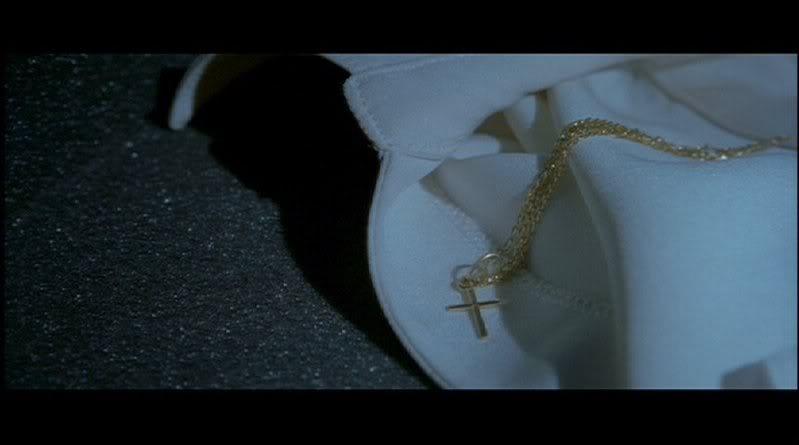
-- The Well-Manicured Man's car's license plate reads "LA365," which may have been a reference to the controversy about moving the show from Vancouver to L.A. to film there all year long (as in 365 days equals a year).
-- As the Well-Manicured Man and Mulder drive through D.C., the limo drives past the Department of Agriculture building, a reference to the tie-in between the bees and the corn crops and "Talitha Cumi" ("the first bee episode" Bowman called it). "It was a little layer to throw in there even if it's too far removed to be understood," said Bowman.
-- "Looking back on the show those first five years we had a lot of flexibility in the types of stories we drew in and the pieces of the mythology because they tended to be chapters," said Frank Spotnitz. "They weren't the big picture about what was going on. But when the movie was released, we felt an obligation ... the expectations were going to be huge that things were going to be revealed in the movie. And that's what prompted the scene between Well Manicured Man and Mulder in the back of the limousine where Well Manicured Man really lays out the whole history of the aliens on earth and in very explicit terms."
-- Bowman called the rat that runs through the background after Mulder is put out of the Well-Manicured Man's car "our lucky rat. It was not us, it was just the good luck of that day."
-- When Kim Manners (the XF's other most prolific director) saw the film, he was devastated when they killed off the Well-Manicured Man. "He was one of my favorite characters," said Manners.
-- "The conspiracy has been part of the show for awhile," said Chris Carter, "and inside every conspiracy, there is politics. The politics in the movie really focus on the Well Manicured Man, the voice of reason in the conspiracy. We've shown that he's a man who does not like to resort to violence, yet he's put in a position by the other members of the conspiracy to commit an act of violence -- to kill Kurtzweil. In doing this they actually set something else in motion. The Well Manicured Man has a bout of conscience. He thinks about his family, he thinks about the future. When he finally does do in Kurtzweil, he takes the opportunity to give Mulder all the proof he'll need that what he's believed all along is true -- that the government has been conspiring to keep secrets -- and in doing so, the Well Manicured Man does something quite heroic. He gives up his own life, and it is on that turn that Mulder will proceed to his ultimate goal."
-- Rob Bowman watched Lawrence of Arabia over and over during filming of the movie to serve as his inspiration for utilizing the width and scale of the movie screen and making The X-Files on a larger and grader scale than ever before.
-- The snow cat that Mulder is driving is a "Tucker" snow cat, a reference to the movie Tucker: A Man and His Dream. Rob Bowman added this in-joke to the movie, noting "'Tucker' was a man up against the 'big' three. He was a small man defeated by the larger conglomerate. I thought that was an interesting parallel with Mulder and what he was trying to do. So it was a layer thrown in there for the fans that go searching for meaning in anything and everything. It was sorta fun." Martin Landau was one of the stars of Tucker.
-- The scenes of Mulder abandoning the snow cat and walking across the snow and of the activity outside the ice station were shot on a glacier in Vancouver which was only reachable by helicopter. "Everybody and everything that was in this sequence -- the snow cats, the camera equipment, all of the personnel including David and me -- were flown up there by chopper," explained Rob Bowman.
-- Bowman also noted that he and David were only on the glacier outdoor set for one day. "There are several shots in that sequence that do not include the real David, nor was I there. E. J. Forrester was up there directing it. We used Mulder's double and some of the running shots on the surface are Mulder's double."
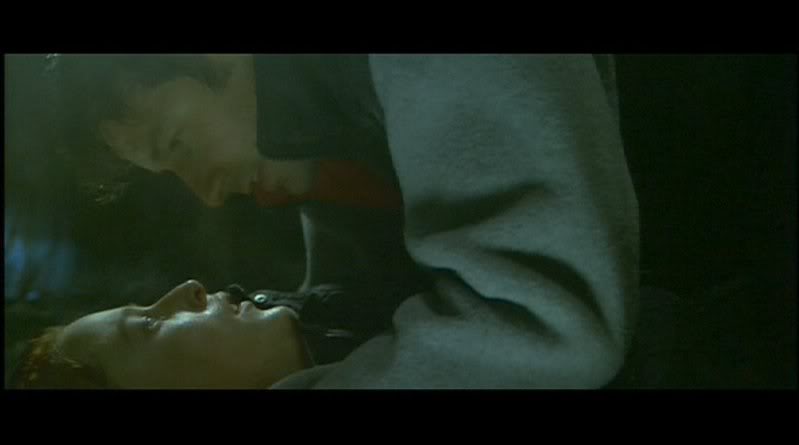
-- After Mulder fell through the ice, Bowman wanted to reveal what was under the ice field one layer at a time, "sort of like peeling an onion." Once it became clear he was inside some sort of structure, Bowman wanted to show how old the ship was and how long they had been encasing human beings by making it clear that some of the pods contained the bodies of Neanderthals like the ones in the opening scene. But the special effects team was unable to get the look just right, and Bowman had to settle for making sure viewers could tell there were human beings in the pods.
-- The images of Scully inside the pod were created by mixing shots of Gillian Anderson immersed in a water tank with shots of a polyurethane "Scully" cast inside a pod.
-- "The day we shot the scene where the ship was coming apart and Mulder had to get Scully out of the pod, David's wife Téa Leoni was on set," said Rob Bowman. "Téa saw us doing the shot where he's carrying Scully away and she suggested a moment where we actually see Mulder take her out of the pod, a very gentle, tender moment between the two of them, sort of in the tone of the kiss. I thought it was a very good idea and we shot it, quickly and simply, but it was a nice moment to add into the movie."
-- "Mulder was supposed to pick me up naked and throw me over his shoulder, so that we'd be 'cheek to cheek'," joked Gillian Anderson. "But we didn't film it that way. If you're not going to see David's bare butt, you certainly aren't going to see mine."
-- Rob Bowman called the scene where the ship starts to come apart and the aliens try to escape the pods "true movie magic" because not much of what's shown in the scene, except for Mulder and Scully, is real. "The sets are wood and nails and paint and the creatures are guys in rubber suits. The secret is to hire the best people and hopefully though the lens, to the audience, it looks real."

-- While trying to escape the disintegrating ship, Mulder spent much of his time toting Scully around. "Gillian isn't heavy," said David Duchovny, "but she weighs more than a lunch pail. I don't think anybody could have actually carried her up that [entire] vertical climb. I like to do stunts for real, to do them myself because it's much better as an actor to actually be doing it so that you're not faking some kind of grimace -- you're actually grimacing. It's better to be actually having a hernia, much better than faking it."
-- The scenes of Mulder and Scully on the ice surface escaping the ship were shot on a sound stage featuring a 120 by 70 foot wide ice field surrounded by green screen. Everything else was supplied by Mat Beck and his model team and CGI team.

-- The close-ups of Mulder and Scully looking at each other on the snow were shot months after principal photography on the film was completed. They were on a 6 by 6 foot chunk of chipped ice in front of a blue background with fake snow blowing around. Although it appeared that Scully muttered "I saw it" after Mulder implores her to look at the escaping ship, in the DVD commentary, Rob Bowman said that he operated the camera while shooting that scene because "I'm trying to compose and stay on the snow and also pull off the idea that once again Scully is not seeing the spaceship. But it was too convenient to have her pass out and then wake up after the ship left. So we just put her into sort of a semi-conscious state throughout. It's only after Mulder collapses that Scully realizes what has just occurred, that he's gotten her out of the ice pod."
-- I wonder what Scully thought created that 75 to 100 foot crater behind her and Mulder! The crater was completely synthetic, created by Mat Beck and his effects crew. "This whole sequence was quite an achievement for everybody," said Bowman. "It was painstaking and things had to be shot over and over. But in the end, it seems to be the popular sequence in the movie."
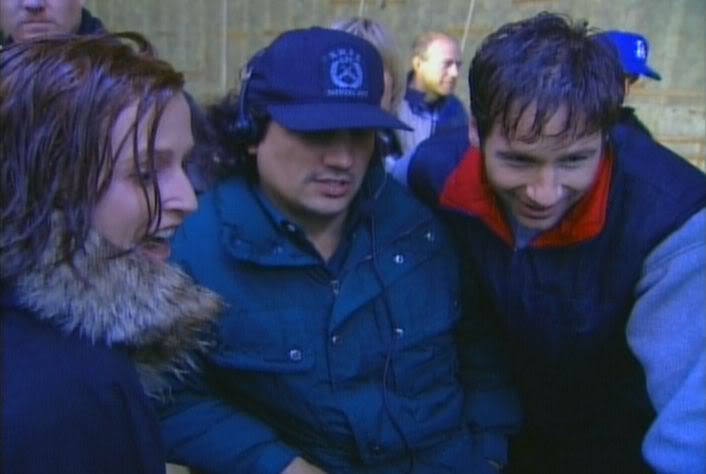
-- The newspaper article Mulder reads at the end of the film (titled "Fatal Hanta Virus Outbreak in Northern Texas Reported Contained") was written by reporter Howard Dimsdale. The real Howard Dimsdale taught X-Files writers Frank Spotnitz and John Shiban at the American Film Institute, and was "blacklisted" during the McCarthy era.
-- The scene of Mulder and Scully in a D.C. park discussing the cover up was actually the second version of the scene. The first version had Mulder showing up and talking to Cigarette Smoking Man, revealing to CSM what he knew based on the conversation in the limousine with Well-Manicured Man. At the end of that scene, Scully showed up and there was a brief moment between Mulder and Scully. "We only tested the movie once for a closed audience," said Rob Bowman, "And the response to that scene was that it was completely out of context within the movie because Mulder and CSM were protagonist and antagonist and never in the movie did they meet. Now they show up in a park and all of a sudden they're conversing as if they were old friends. Well, they are old acquaintances in the series, but not to the first time viewer. So we decided that the best thing to do would be to re-shoot and have CSM enter into that scene in a different way. So we re-shot it and we actually improved it because we made it more a scene about Mulder and Scully and their relationship, their quest, and their bond. Then, at the end of that scene, we had CSM up on a hill having watched them and realizing that he's going to have to stay on them because they are going to be a continued nemesis. But in the end, we cut that out because it seemed impervious to what was the alternate ending."
-- As the movie closes, Cancerman and Strughold continue their colonization plans in Foum Tataouine, Tunisia. Foum Tataouine is a real place in Tunisia, but the location was used in the movie as a nod to Twentieth Century Fox's other sci-fi movie Star Wars. In the XF film, the footage of the helicopter flying over the sand dunes was shot in Southern California near the Mexican border in the same location where much of the original Star Wars desert footage was shot. Also, Luke Skywalker's home was on Tatooine.
-- The telegram tossed in the sand at the end lets us know that the X-Files have been reopened; but oopsie? At the top, the telegram reads 0906970233P EST, which would appear to be the date (September 6, 1997) and the time (2:33 p.m. eastern standard time) that the telegram was sent. Although the movie was shot in the summer of 1997, the events that took place in it were to follow Season 5, which means the telegram should have been dated 1998.
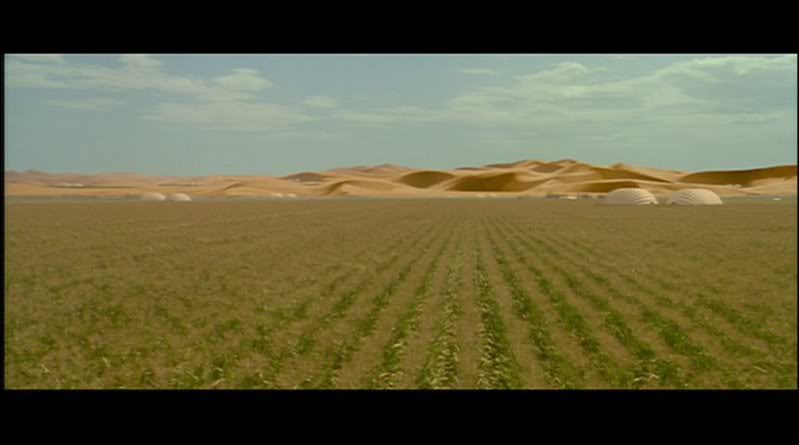
-- "The only thing real about the final shot in the movie (above) is the corn," said Rob Bowman. "The domes, the sand dunes, the sky is all fake and as a matter of fact, even some of the corn was replicated through the shot to make it look like it's a bigger field than it really is."
-- Mark Snow, who composed the music for the movie, said that Chris Carter wanted "a very minimal approach; not much melody, just ambient atmospheric sound design and he wanted a lot of it. Discordant and minor key stuff." A thrill for all involved with the show, especially Mark Snow and Chris Carter, was recording the score with an 85-piece orchestra. This was the first time the X-Files theme was played with an orchestra.
-- Two soundtrack albums were released in conjunction with the film, Mark Snow's orchestral score and an album featuring songs "inspired" by the movie, a few of which actually appeared in the movie or during the closing credits -- "One" by Filter; "Crystal Ship" by X; "Walking After You" by the Foo Fighters; and "Teotihuacan" by Noel Gallagher. Music used in The X-Files trailers came from "Romeo and Juliet" -- "O Verona" and "Escape to Mantua," featuring Mundy.
-- The "hidden" track on "The X-Files: The Album" (the soundtrack album - not Mark Snow's score) takes place 10 minutes and 13 seconds into the last track. The "hidden" track is a spoken word piece by creator Chris Carter, who explains some of the Syndicate's history and motivation.
-- "Fight the Future" was not originally intended to be part of the movie's title. The phrase was supposed to be used as a sort of tag-line (much like "The Truth is Out There" for the series), but it was printed so close to the words The X-Files on the movie posters that people began to assume it was part of the title. So it stuck.
-- The film wrapped just as production of The X-Files fifth season was getting underway in Vancouver. The first fifth season episode filmed, "Unusual Suspects," heavily featuring the Lone Gunmen, was borne out of necessity, as David Duchovny and Gillian Anderson were still filming the movie in Los Angeles. Other re-shoots continued well into the fifth season.
-- "The first time I saw David and Gillian on a movie screen," said Chris Carter, "they came on screen and I was kind of startled. I had never seen them so huge, not like I was used to seeing them. There was a moment where I had to kind of shake myself and then I looked at them and realized that they're going to be on the big screen and they're going to be movie stars. And they filled those bigger shoes, if you will, every bit as well as one hoped they would."
-- Frank Spotnitz said, "What we finally revealed in the movie was that the black oil was a virus that has been around since before man was around, alien in origin that has taken over the universe and ultimately that's what colonization on earth would be ... this black oil infecting us. And that's why the bees were being bred to carry the black oil virus, to sting people, to spread it that way. After that movie, if you look at the mythology episodes that followed, they tend to be much more about the heart of the conspiracy, the heart of what's going on, the heart of what's going to happen in the future. All of those episodes after the movie were written with a certainty that we were heading toward the end, even if we didn't know exactly when the end was going to take place."
-- The film held its world premiere at the Mann Bruin Theatre in Westwood on June 11, 1998. Many of the XF family attended the premiere including Chris Carter, Frank Spotnitz, Rob Bowman, David Duchovny, Gillian Anderson, Martin Landau, John Neville, William B. Davis, Mitch Pileggi, Mimi Rogers, Nick Lea, Laurie Holden, and Mark Snow. Other famous faces who attended included Jennifer Tilly, Jacqueline Bisset, Luke Perry, Christina Applegate, Carol Alt, Kelly Preston, Scott Wolf, Bill Maher, Mark Hamill, David Boreanaz, Vincent Young, Chastity Bono, Angie Everhart, and Martin Short.
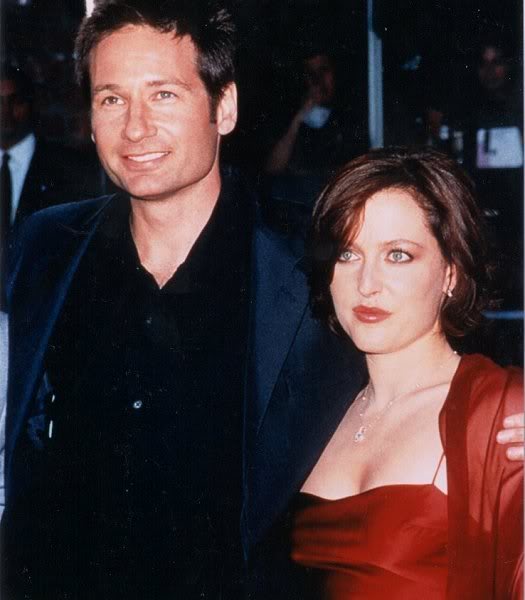
-- The fans who sat in the bleachers outside the movie premiere got a free copy of the FTF soundtrack CD.

-- At the premiere, David Duchovny was asked if there was a lot of pressure at home to outperform Téa Leoni's film Deep Impact which was released on May 8, 1998. "Yes," he joked. "There's a lot of pressure to perform."

-- The film opened wide on June 19, 1998, the height of the summer blockbuster season. According to several different May 1998 newspaper articles on the rising costs of film production, 20th Century Fox spent around 60 million dollars promoting the film worldwide, and the production budget, originally said to be 60 million dollars as well, was eventually revealed to have been closer to 66 million. With a minimum expenditure of $126 million for production/promotion, the movie had a worldwide gross of slightly over $189 million, of which the studio would have received about 55 percent.
-- Martin Landau (Alvin Kurtzweil) started his long acting career with guest roles on many popular series of the 1960s -- Bonanza, Wagon Train, Maverick, Rawhide, and The Untouchables to name a few. He appeared on the big screen in 1963's Cleopatra starring Elizabeth Taylor and Richard Burton and in 1965's The Greatest Story Ever Told. More TV roles followed, and in 1969 he was cast as Rollin Hand in the TV series Mission: Impossible, for which he was nominated for an Emmy three times. After leaving the series, he found steady work in film and television, and in 1989 appeared as Abe Karatz in Tucker: The Man and His Dream starring Jeff Bridges and in which Peter Donat (Bill Mulder) also appeared. Landau won a Golden Globe for his role in Tucker and received his first Academy Award nomination for Best Supporting Actor. The following year he appeared in Woody Allen's Crimes and Misdemeanors and received another Academy Award nomination, again for supporting actor. In 1994 he appeared in Tim Burton's Ed Wood, the story of the legendary director of truly awful movies (including one of Mulder's favorites, Plan 9 From Outer Space), with Johnny Depp in the title role. Landau played real-life horror film actor Bela Lugosi; and the third time was the charm: Landau was once again nominated for and won the Academy Award for Best Supporting Actor for the film. (He also won nearly every Critics Award for the role, as well as the Golden Globe.) Since his role in Fight the Future, he's shuffled easily between TV and films, receiving two Emmy Award nominations for his role as Frank Malone on Without a Trace. Most recently, he appeared as Bob Ryan in three episodes of the HBO series Entourage.
-- Distinguished German actor Armin Mueller-Stahl (Conrad Strughold) appeared in the film Avalon and received an Academy Award nomination for his supporting role in the film Shine for which Geoffrey Rush received the Best Actor Oscar.
-- Jeffrey DeMunn (Dr. Ben Bronschweig) had a recurring role in the Law & Order series as Professor Norman Rothenberg. He can currently be seen as Art Weissman in Hollywoodland.
-- Blythe Danner (Jana Cassidy) began her acting career on the stage and won the 1970 Tony Award for her role in "Butterflies Are Free." She played Martha Jefferson in the 1972 film version of the Broadway musical 1776, with Ken Howard (The White Shadow) playing Thomas Jefferson. They also worked together in the highly-touted but short-lived 1973 TV adaptation of the Tracy and Hepburn film Adam's Rib. In fact, they worked together so often that many people thought they were married. But in reality, Danner was married to director Bruce Paltrow from 1969 until his death in 2002. Danner and Paltrow had two children, Jake and Gwyneth (an Academy Award winner for her role in Shakespeare in Love). Danner appeared in the hit films Meet the Parents and Meet the Fockers and has most recently appeared in recurring roles on TV's Will and Grace and the Showtime series Huff. In 2005, she became the first woman to be nominated for three Emmy Awards in the same year (as Outstanding Lead Actor in a Miniseries or Movie for Back When We Were Grownups; for Outstanding Guest Actress in a Comedy Series for Will & Grace; and for Outstanding Supporting Actress in a Drama Series for Huff. She won in 2005 and again in 2006 for her role in Huff.
-- Lucas Black (Stevie) was "discovered" in Billy Bob Thornton's Oscar-winning film Sling Blade. After falling down the hole and being infected by the Oilien in Fight the Future, he went on to film roles in All the Pretty Horses (with future XFiler Robert Patrick), Cold Mountain, Jarhead, and Friday Night Lights with his Sling Blade co-star Billy Bob Thornton.
-- Glenne Headly appeared as the Barmaid in an uncredited performance. She has appeared in many films and in memorable guest roles on TV in Frasier and the acclaimed miniseries Lonesome Dove.
Once & Future Retreads: Terry O'Quinn (Darius Michaud) appeared in Season 2's "Aubrey" and in Season 9's "Trust No 1." Michael Shamus Wiles (Black-Haired Man) appeared in the sale role in "The End" and "En Ami." Steve Rankin (Field Agent) was U.S. Marshal Daddo in "Orison." Gary Grubbs (Fire Captain Miles Cooles) was Sheriff Tom Arens in "Our Town." Scott Alan Smith (Technician) played the Prison Doctor in "Drive." David Duchovny's buddy Jason Beghe appears in an uncredited role as an FBI Agent at the bomb site; he played "Freddie" Larry Moore in "Darkness Falls."

(Thanks to chrisnu, about dd, and duchovny.net for today's pics.)
Please share your first impressions, favorite (or cringe-worthy) moments, classic lines, favorite fanfic, nagging questions, repeated viewing observations, etc., as today we celebrate The X-Files Movie: Fight the Future!
Polly
"I have; I did; it's done."
P.S. A month or so ago, someone here at Haven asked the question why the original "I Want to Believe" poster in Mulder's office was switched to a different poster at some point during the series. While doing publicity for Fight the Future, Carter was asked about this. "There was a little copyright-infringement problem with the original spaceship on that first poster," he explained, so the poster was reworked slightly.